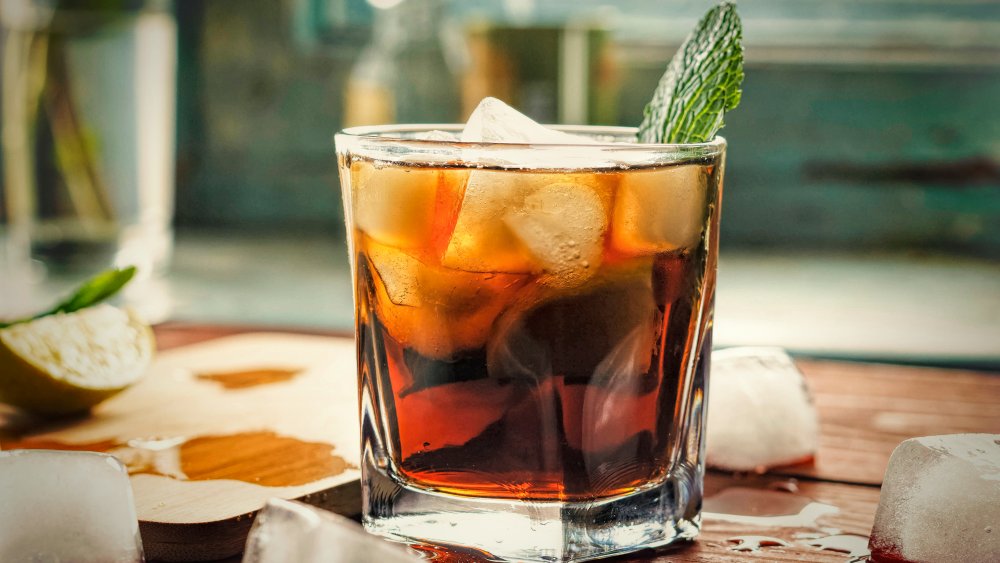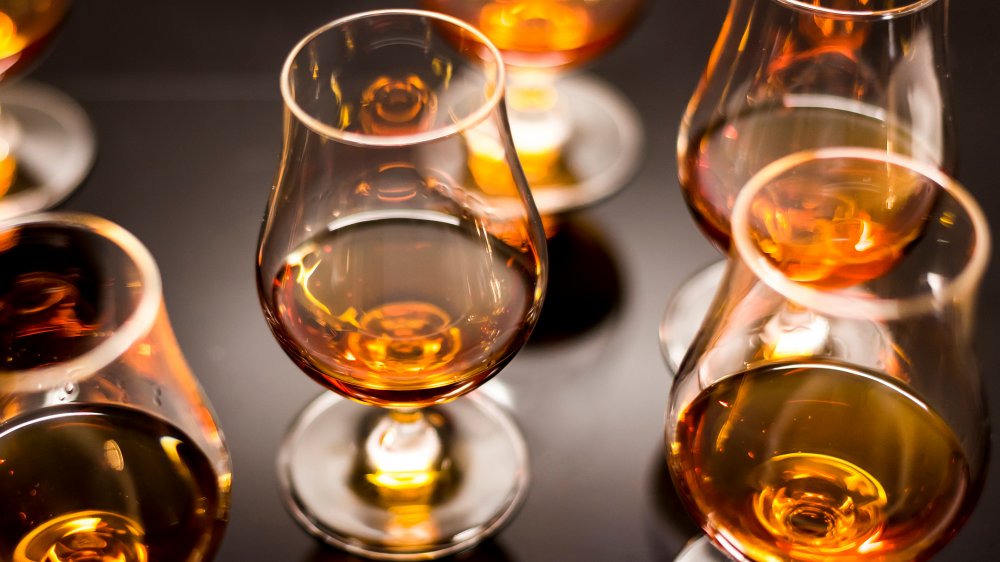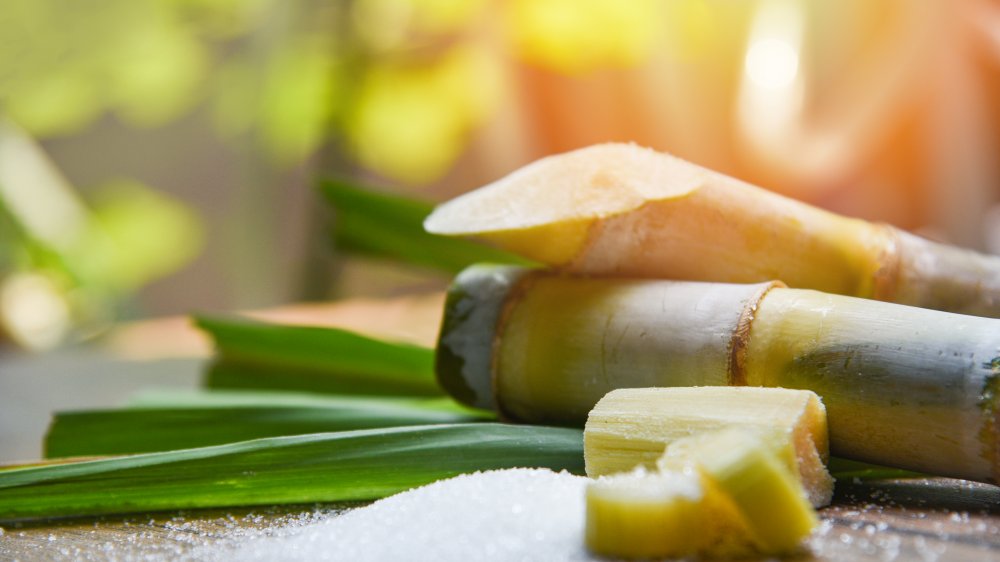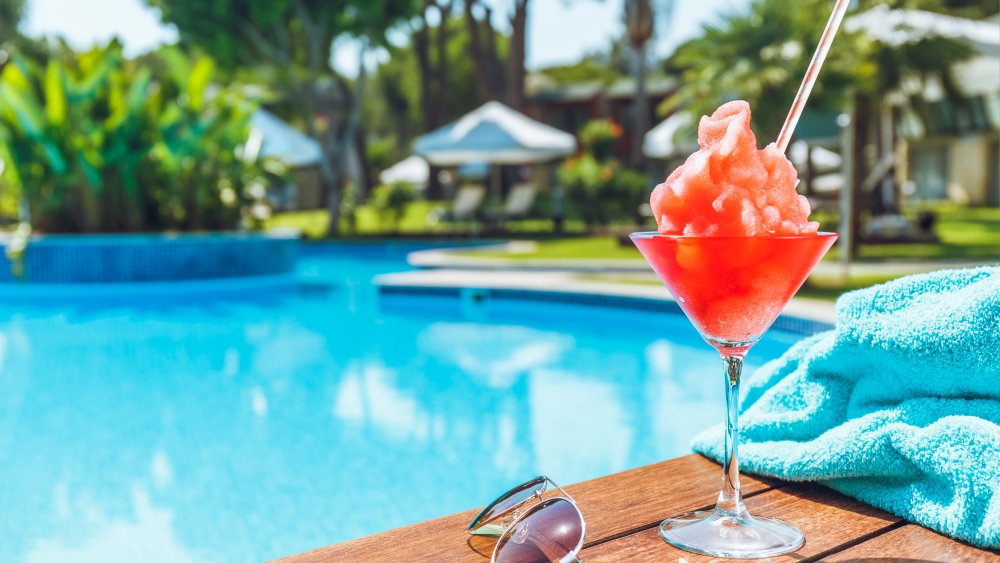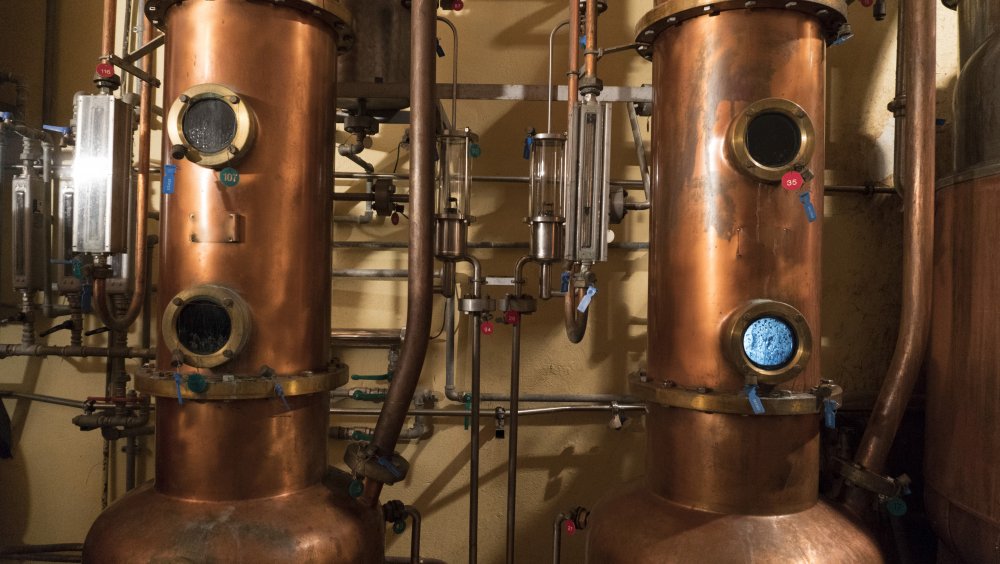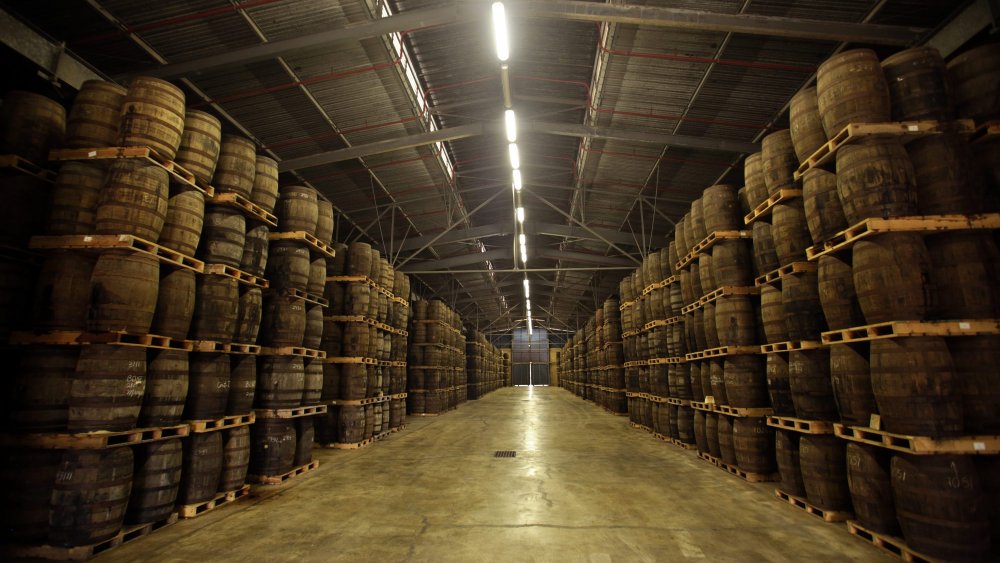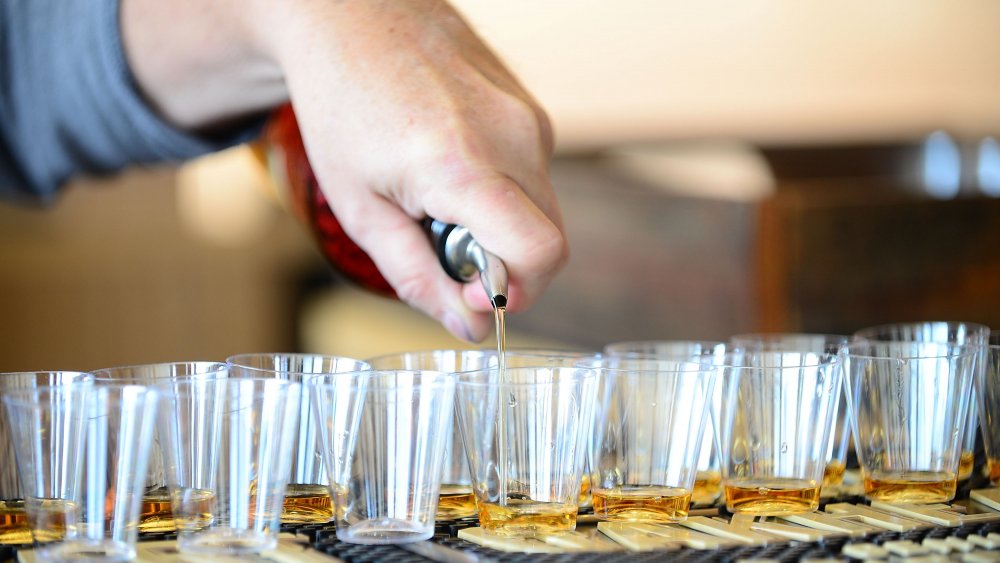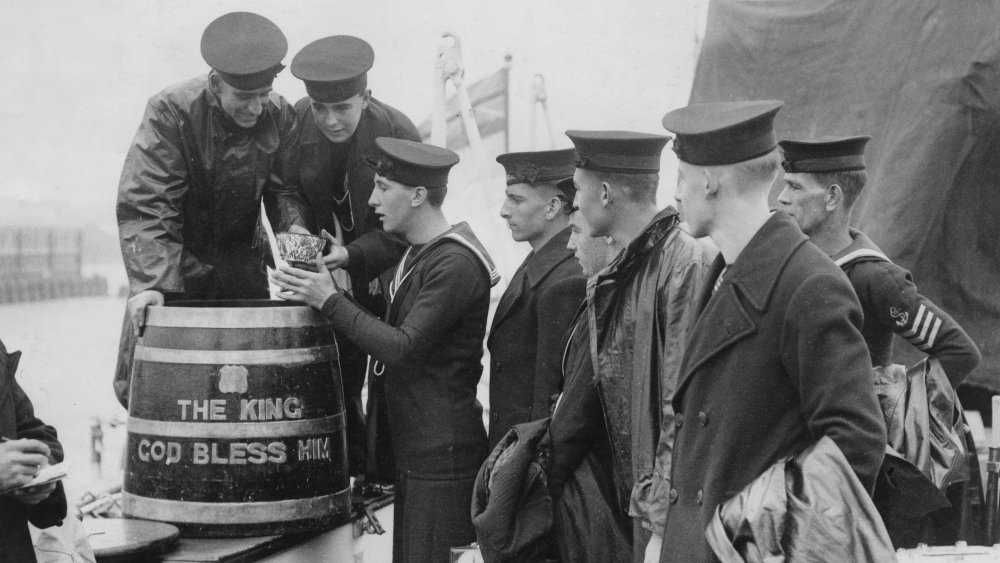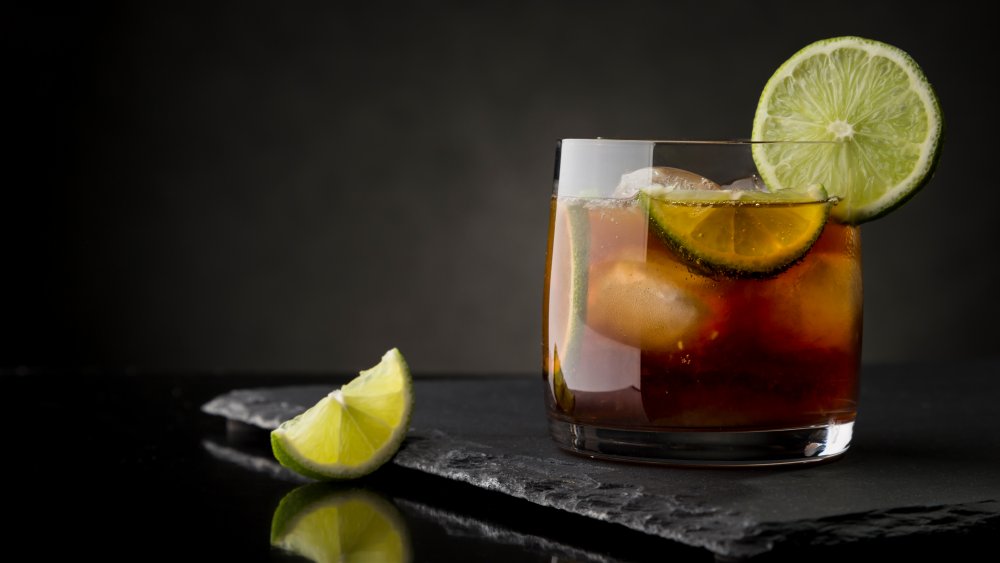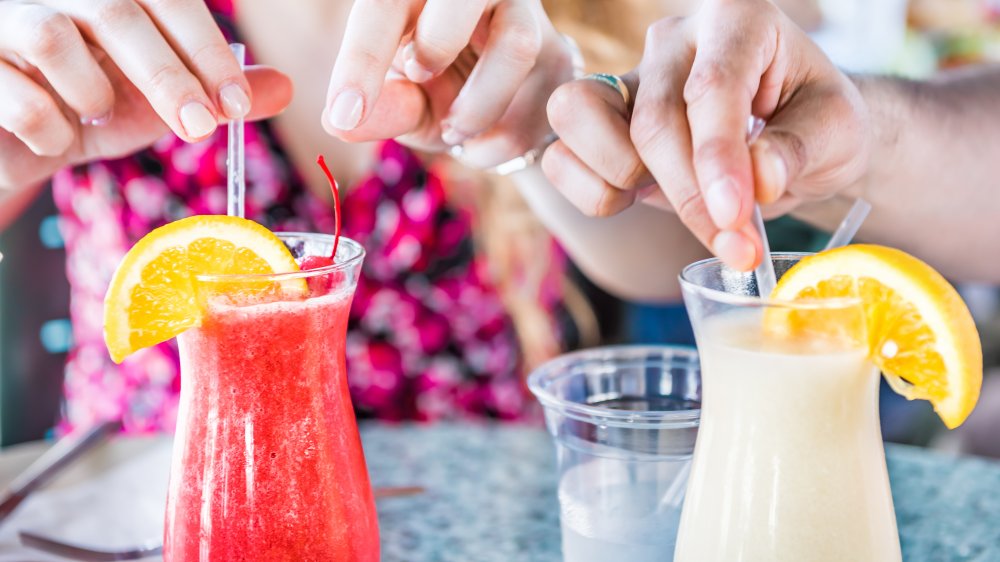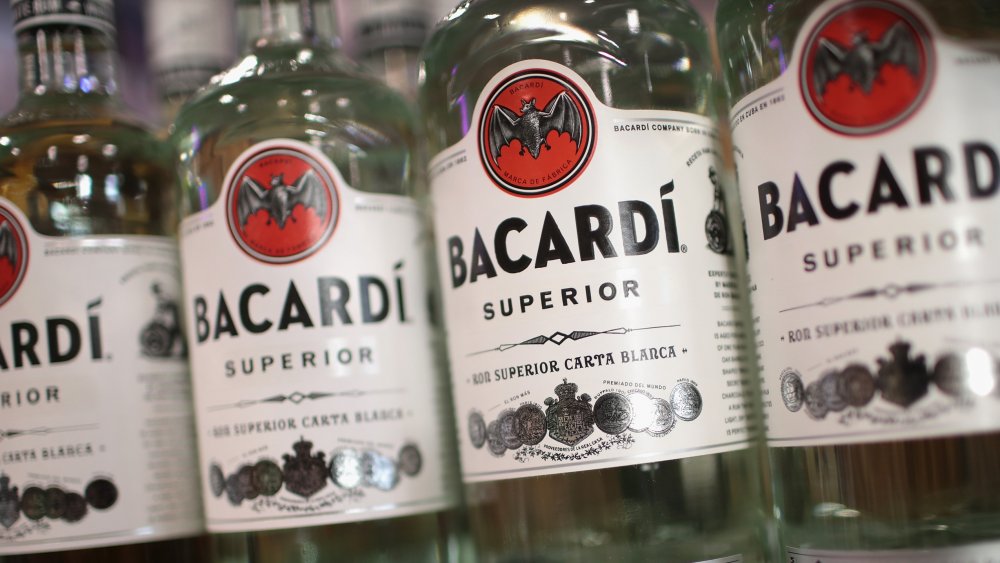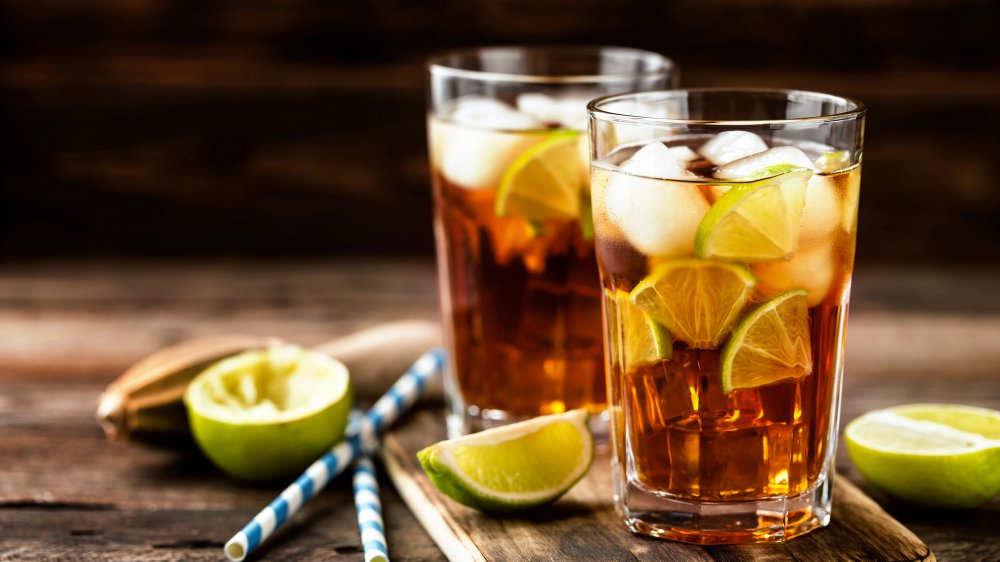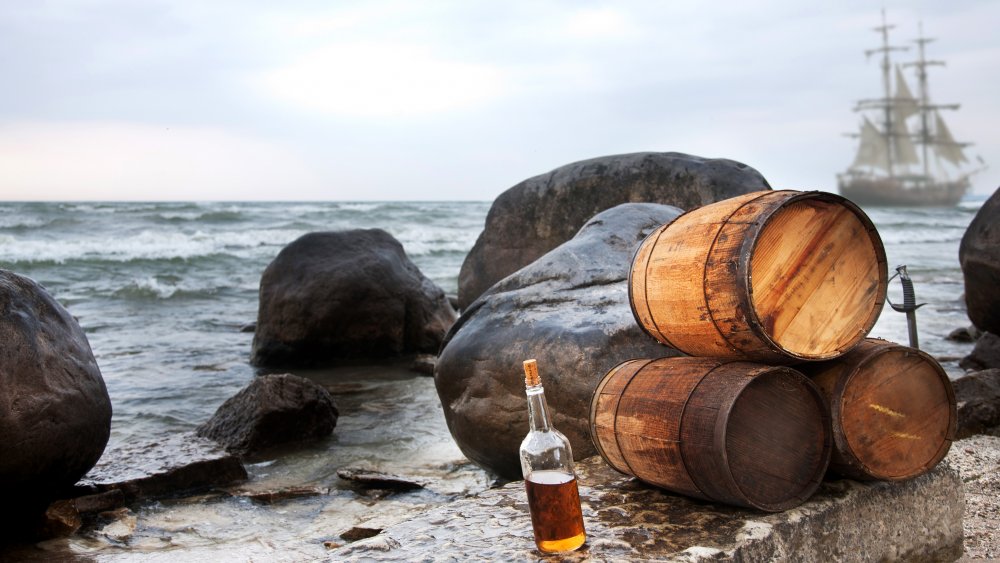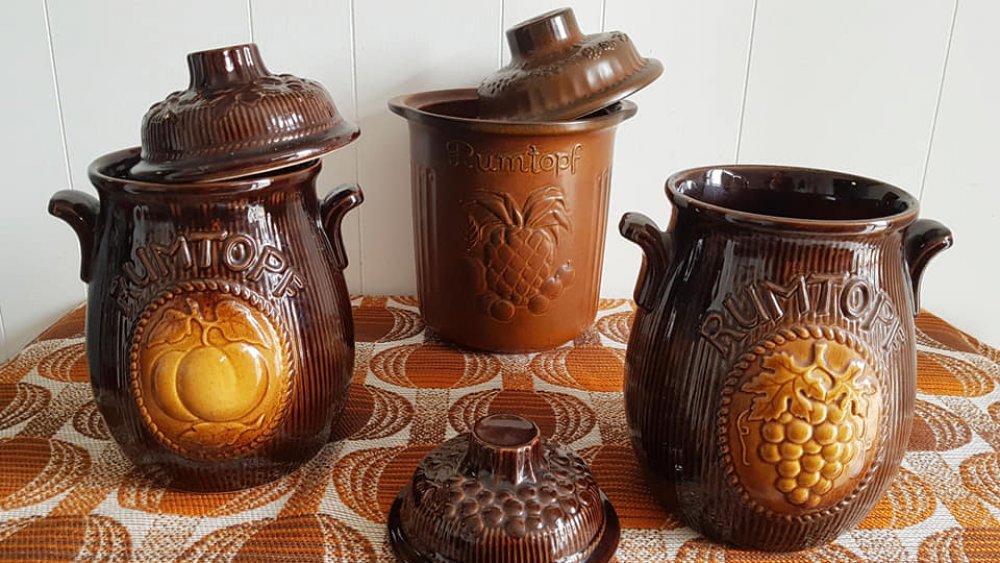What You Should Know Before Taking Another Sip Of Rum
When thinking rum, plenty of classic images may come to mind. The spirit has a tendency to remind most people of vivid illustrations of relaxing on white sandy beaches by the sea in the Caribbean. It creates a craving for piña coladas, it might make you think about The Godfather and sipping daiquiris in Cuba, and, of course, who could forget Jack Sparrow from The Pirates of The Caribbean — seriously, why is the rum always gone?
Rum is certainly a popular alcohol, often mixed into fruity cocktails at the bar. But because the types of rum out there vary so much, one might also like sipping a rum neat or on the rocks, similar to how'd you enjoy glass of scotch or bourbon. It's not just about spring break parties and poolside bars with this carefully crafted spirit. As it turns out, there is so much more to rum than meets the eye.
What exactly is rum made out of? How did rum get its start and end up becoming one of the most popular spirits on the market? Mashed dove in to take a closer look. This is what you should know before taking another sip of rum.
Rum has been around for centuries
While rum may seem like it's only been gracing cocktails with bright umbrellas for a few decades, it's actually one of the oldest spirits on the market. In fact, rum has been around for hundreds of years.
The first record of rum dates all the way back to 1650, when it went by the name of "kill-devil" and "rumbullion." After 17 years under those names, it finally just stood on its own as "rum." It was pretty common to make rum with molasses in those days as the syrup was so readily available. By 1655, the British Navy began giving a half pint of rum to each sailor daily, according to Forbes. With that British Navy stamp of approval, it's not hard to imagine that others would catch on by enjoying it as their daily nightcap.
Early colonists to the Americas seemed to love rum too, and production got an early start in the United States when the first U.S. distillery opened on Staten Island, New York, in 1664. And while we consider bourbon as the official American spirit today, rum certainly had its roots in the U.S. long before.
Most rums are still made with molasses
Any type of alcohol, whether its wine, beer, or liquor is always characterized by the type of sugar that is being used for the fermentation process. When yeast is introduced in the process, it eats the sugars found in grapes for wine or grain for beer and spirits, ultimately turning it into alcohol.
For rum, it's all about the baseline of sugar cane. Similar to the way asparagus is grown and harvested as a perennial, sugar cane grows tall, and when it's ready to be harvested, stalks are cut with machetes. Sometimes a stalk can produce a harvest two times per year, but many other crops only produce once per year. Sugar cane is made up of sugar, fiber, and water. The water and sugar juice are extracted from the stalk to later be fermented. Once the fresh sugar cane juice is fermented, it's ready to be distilled into rum.
Most types of rum are still made from molasses, though, which is essentially leftover when sugar cane juice is refined into the typical granulated sugar we all use in home recipes.
Rum is wildly popular in cocktails
Lighter or clear spirits such as vodka, gin, and white rum offer the ideal base for cocktails because of the way they can take on different flavor profiles and mesh together so well. Certainly, a cocktail with bourbon or scotch can be ordered at the bar, but because of their complex flavors, they're not as common. Rum pairs well with tropical and fruity flavors because of its sweetness, and it's been used in a number of cocktails behind the bar for a very long time.
The daiquiri, a classic drink served either shaken or blended, is definitely one of the most popular rum drinks, and this concoction has been around since the early 1900s, according to Difford's Guide. Pairing rum with lime, honey, and water, the drink became incredibly popular as people were looking for ways to enjoy rum rather than sipping it straight.
Years later in 1954 came the piña colada, taking the crown as one of the most popular blended drink options. It was created in Puerto Rico by blending rum, coconut cream, and pineapple juice, and eventually, was declared the national drink of Puerto Rico in 1978.
Rum is produced in many countries
Rum may bring to mind thoughts of Caribbean climates and white sandy beaches. It's certainly not incorrect to think about rum coming from those areas. Whereas many other spirits are typically produced in one specific locale, such as Irish whisky, scotch, and bourbon, rum is actually produced all over the world. But don't worry, there are a few Caribbean countries in that mix.
Barbados produces some seriously tasty rum, according to Thrillist, which makes sense given this tropical country is actually known for the first sale of rum. Rum made in India tends to be a bit thicker and darker than rums made elsewhere, but residents of this country seem to love it. The rum produced in Cuba tends to have a higher proof, making it a bit lighter and more refreshing.
Rum makers in the small country of Guyana love to play with flavors when it comes to rum. Often, rums from Guyana will feature more spice, along with vanilla and honey, to make the rums all the more flavorful and complex. Each country where rum is produced has its own specific characteristics, making rum all the more interesting.
The way a rum is aged will change its color
Rum comes in so many different forms, but this is what it all boils down to (or should we say distills?): Rum varies by both where it is produced and how much time the alcohol spends in a barrel. Interestingly both light and dark rums start out as a clear liquid.
To make rum, either sugar cane juice or molasses is mixed with water and yeast to ferment. The fermented result is referred to as a "wash" and is distilled. The mixture of alcohol and water is boiled, which gives off vapors. Once those vapors are cooled, they'll be condensed and ultimately distilled. Once distilled, the clear rum may be aged in a stainless-steel tank, where it won't take on any color characteristics at all. Clear rums may also make their way into a barrel, typically aged for one year to take on some of the barrel's characteristics and create a smoother spirit. Once aged, the liquid is removed from the barrel, and the color is filtered out.
Golden or darker rums, on the other hand, spend more time in the barrel, taking on the characteristics of the wood along with gaining a smooth texture. Aging in oak barrels produces a golden rum whereas a charred oak barrel will make for a dark rum.
There are so many different types of rum
Rum may seem like a straightforward spirit. It's the stuff that goes into that favorite spring break cocktail, right? That's not exactly the case. Since there's a huge variety in types of rum, there are also specific characteristics of each — and not all are fit for mixing into mojitos.
White rum, which is also classified as clear, silver, or light rum, is most commonly used in those classic poolside bar drinks with fruity garnishments, topped with an umbrella. They're super light in flavor, making them perfect for mixing. Gold rums are next on the color and flavor profile, with time spent aging in a barrel, giving a smoother and more complex sip. These types of rum are often used for your classic rum and Coke. Dark rum comes in with a super complex, deep, dark flavor profile thanks to its time spent in the barrel. This kind of rum can be sipped neat just like you'd do with a nice bourbon or scotch.
Rum also lends itself well to being flavored or spiced, and both clear and some types of dark rum can take on additional flavor additions. Spiced rums with the addition of vanilla and cinnamon, or even pumpkin spice, are the perfect cool-weather libation.
A simple rum drink prevented this illness in the British Navy
During the late 15th and early 16th centuries, the threat of scurvy was very real, and the ailment was killing sailors left and right. Characterized by a severe lack of Vitamin C, scurvy worsened in a few weeks' time, but early symptoms of weakness, low-grade fevers, and sudden exhaustion would set in.
Because Vitamin C is needed in the body to absorb iron, heal wounds, play a role in creating neurotransmitters such as dopamine, and help to keep connective tissues in the body strong, a severe deficiency was certainly not helpful around the time when Columbus and his men were making the transatlantic voyage. Scurvy was to blame for more than two million sailors perishing at sea, taking their lives more commonly than storms or combat put together.
With rum being so easily accessible in Caribbean countries by the sea, the spirit became the drink of choice for one of the British Navy's squadrons in 1655. The spirit caught on and British Navy sailors across the entire fleet were being given a daily ration of rum two times per day by 1731, with rations being given at wildly high strengths. Over time, it was realized that the daily ration of rum paired wonderfully with the sailors' daily ration of lime juice, as the Vitamin C found in the juice was divvied out to ward off scurvy.
Rum may have some health benefits
What if all this time we were drinking piña coladas with our chips and salsa and sipping daiquiris under a beach umbrella, there were actually some health benefits coming along with it? As it turns out, that concept isn't too farfetched.
Sipping a shot of rum doesn't come with any fat or carbohydrates, so right off the bat, you're saving on that when it comes to your daily fat and carb intake. The only calories are coming from the alcohol, with seven calories per gram. As Verywell Fit reported, rum may even have the potential to increase bone density, reducing the risk of osteoporosis. It has also been noted that the moderate consumption of rum could help to increase good cholesterol and help to reduce muscle pain. And just as the British Royal Navy utilized their ration of rum as the perfect pairing for lime juice to fight scurvy, rum is a great-tasting spirit to mix with fruit juice today. While you probably aren't concerned about scurvy, rum mixed with lemon juice and honey — a hot toddy — can alleviate sore throats from the common cold.
And while all of these potential health benefits sound great, it is important to remember that rum is still produced with a high alcohol content, and overconsumption certainly has the potential to cause more harm than good.
Rum drinks may give you the worst hangovers
Have you ever been sitting at a bar or by the pool, sipping one-too-many Mai Tais? Those will hit your fast, as they're typically made with three types of rum, plus orange Curacao liqueur, lime, and ice. It's basically all liquor in that glass. And while those Mai Tais might offer a nice buzz for a little bit, it'll hit you even harder with a terrible hangover in the morning, just as the majority of sugary rum drinks will do.
The severity of your hangover may have to do with the amount of congeners that were in your drink. Congeners are "a byproduct of fermentation that gives certain alcohols their deep colors" and they "tend to heighten hangover symptoms," Tory Tedrow, registered dietitian, told Business Insider.
Because of the congeners found in whiskey, brandy, and rum, these spirits are notoriously bad for causing the worst hangovers. Then, once you combine your rum with plenty of sugar as bartenders do in piña coladas, daiquiris, or hurricanes, you're adding even more fuel to the fire, as copious amounts of sugar will make you feel bad enough.
The largest rum distillery is located in Puerto Rico
Rum is certainly made in a lot of different countries as it spans multiple types and styles. But there's one company that's been pumping out a huge chunk of the world's rum for centuries, and it now boasts the largest rum distillery on Earth.
Bacardi started producing rum in 1862, and by 1930, the plans to open production facilities in Mexico and Puerto Rico came to fruition. Now, Bacardi's Puerto Rico distillery is responsible for producing 85 percent of the spirit company's global distillation. In that distillery alone, over 100,000 liters of rum is produced every single day. It's no surprise, then, that Bacardi's Puerto Rico distillery earns the title for the largest rum distillery in the world.
And the company certainly needs that large of a distillery (plus a few more in Mexico and India), as Bacardi was ranked second in the top 10 best-selling rum brands for 2019. Just in that year alone, Bacardi sold through 17.8 million cases of its popular rum.
There are a ton of theories on how rum got its name
With rum's storied past plus the fact that rum has been produced in a huge number of countries around the world, it's not surprising that this spirit would have a variety of names. And over the years, plenty of theories have looked to explain how we all came to know rum by its current name.
One such theory is that rum came from the word "rummer," derived from the Dutch word "roemer." This is due to the history surrounding Dutch settlers and their sugar cane farming in Barbados. The rummer was a large goblet, similar to a wine glass, with a large footing that featured beautiful, intricate detailing. Perhaps it was the perfect vessel for enjoying a glass of rum, and the name was borrowed and shortened from its moniker.
Because rum is made from fermented sugar cane, another theory brings sugar into the mix. The Latin word for sugar is "saccharum," leading way to a theory that the third syllable in the word was utilized as an English translation. Rum had also gone by the name "rumbullion" as records from around 1650 show, so perhaps it was decided that keeping the first syllable and just calling it rum would be simpler.
Rum has a bit of a dark past
While rum certainly seems like all piña coladas and colorful umbrellas, also has a pretty dark side — including ties to what was known as the Triangle Trade. The trading of enslaved people between England, Africa, and North America all began when Sir John Hawkins started his voyages from England in the 1560s, and the operations continued until the Slave Trade Act abolished it in 1807.
Hawkins was responsible for trading English goods for enslaved people from Africa. From there, slaves were traded in the New World for goods that made their way back to England. The route was a strategy used to move goods, and over time other routes began to pop up.
Those in New England needed access to molasses and cane sugar from the islands of the Caribbean for making rum. At the time, molasses and sugar made its way from the West Insides to New England. Once the sugars were used to convert into rum, the liquor was sent to Africa, where it was exchanged for enslaved people. Those who were enslaved were then transported to the New World and sold.
Rum can be used to preserve fruit
As it turns out, rum isn't just for drinking. It has other uses as well. In Germany, it's actually utilized to preserve fruit. It's not uncommon to see little ceramic jars in German kitchens called a rumtopf. The jars are meant to house fresh fruit, picked at the peak of the season. Sugar and rum are added into the jar to help to keep the fruit from spoiling, all while transforming it into a sort of chunky, fruity, syrupy liqueur. This fruity, boozy syrup then becomes the ideal complement for ice cream, pie, or cake.
The idea is to preserve fruit when they're in season so that when winter comes around, it can still be enjoyed. Often, mixtures of different types of fruit are added, as those fruits come in season and are freshly picked. Certainly, if you don't have a traditional rumtopf jar of your own, the same concept can still be utilized to make the perfect topping for desserts by combining ripe fruits with sugar and high-proof rum in a glass jar or other container. After a few months, your preserved fruits will be ready to enjoy.
